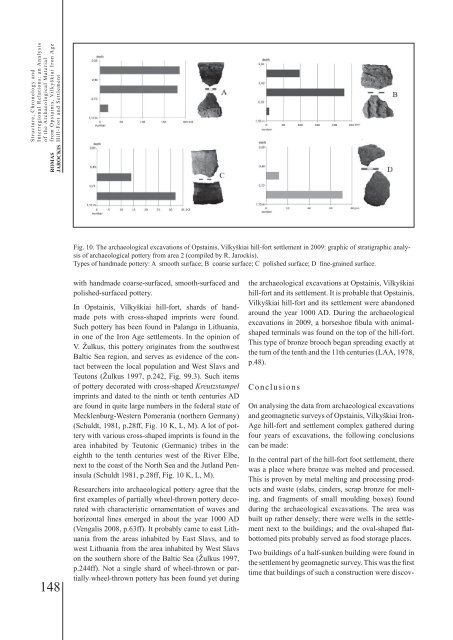BALTICA17 - KlaipÄdos universitetas
BALTICA17 - KlaipÄdos universitetas
BALTICA17 - KlaipÄdos universitetas
Create successful ePaper yourself
Turn your PDF publications into a flip-book with our unique Google optimized e-Paper software.
ROMAS<br />
JAROCKIS<br />
Structure, Chronology and<br />
Interregional Relations: an Analysis<br />
of the Archaeological Material<br />
from Opstainis, Vilkyškiai Iron Age<br />
Hill-Fort and Settlement<br />
Fig. 10. The archaeological excavations of Opstainis, Vilkyškiai hill-fort settlement in 2009: graphic of stratigraphic analysis<br />
of archaeological pottery from area 2 (compiled by R. Jarockis).<br />
Types of handmade pottery: A smooth surface; B coarse surface; C polished surface; D fine-grained surface.<br />
148<br />
with handmade coarse-surfaced, smooth-surfaced and<br />
polished-surfaced pottery.<br />
In Opstainis, Vilkyškiai hill-fort, shards of handmade<br />
pots with cross-shaped imprints were found.<br />
Such pottery has been found in Palanga in Lithuania,<br />
in one of the Iron Age settlements. In the opinion of<br />
V. Žulkus, this pottery originates from the southwest<br />
Baltic Sea region, and serves as evidence of the contact<br />
between the local population and West Slavs and<br />
Teutons (Žulkus 1997, p.242, Fig. 99.3). Such items<br />
of pottery decorated with cross-shaped Kreutzstampel<br />
imprints and dated to the ninth or tenth centuries AD<br />
are found in quite large numbers in the federal state of<br />
Mecklenburg-Western Pomerania (northern Germany)<br />
(Schuldt, 1981, p.28ff, Fig. 10 K, L, M). A lot of pottery<br />
with various cross-shaped imprints is found in the<br />
area inhabited by Teutonic (Germanic) tribes in the<br />
eighth to the tenth centuries west of the River Elbe,<br />
next to the coast of the North Sea and the Jutland Peninsula<br />
(Schuldt 1981, p.28ff, Fig. 10 K, L, M).<br />
Researchers into archaeological pottery agree that the<br />
first examples of partially wheel-thrown pottery decorated<br />
with characteristic ornamentation of waves and<br />
horizontal lines emerged in about the year 1000 AD<br />
(Vengalis 2008, p.63ff). It probably came to east Lithuania<br />
from the areas inhabited by East Slavs, and to<br />
west Lithuania from the area inhabited by West Slavs<br />
on the southern shore of the Baltic Sea (Žulkus 1997,<br />
p.244ff). Not a single shard of wheel-thrown or partially<br />
wheel-thrown pottery has been found yet during<br />
the archaeological excavations at Opstainis, Vilkyškiai<br />
hill-fort and its settlement. It is probable that Opstainis,<br />
Vilkyškiai hill-fort and its settlement were abandoned<br />
around the year 1000 AD. During the archaeological<br />
excavations in 2009, a horseshoe fibula with animalshaped<br />
terminals was found on the top of the hill-fort.<br />
This type of bronze brooch began spreading exactly at<br />
the turn of the tenth and the 11th centuries (LAA, 1978,<br />
p.48).<br />
Conclusions<br />
On analysing the data from archaeological excavations<br />
and geomagnetic surveys of Opstainis, Vilkyškiai Iron-<br />
Age hill-fort and settlement complex gathered during<br />
four years of excavations, the following conclusions<br />
can be made:<br />
In the central part of the hill-fort foot settlement, there<br />
was a place where bronze was melted and processed.<br />
This is proven by metal melting and processing products<br />
and waste (slabs, cinders, scrap bronze for melting,<br />
and fragments of small moulding boxes) found<br />
during the archaeological excavations. The area was<br />
built up rather densely; there were wells in the settlement<br />
next to the buildings; and the oval-shaped flatbottomed<br />
pits probably served as food storage places.<br />
Two buildings of a half-sunken building were found in<br />
the settlement by geomagnetic survey. This was the first<br />
time that buildings of such a construction were discov-

















